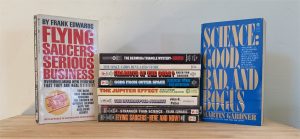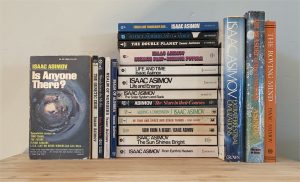I went through a brief phase of interest in pseudo-science.
 Beginning at that 7th grade book fair when I bought (in addition to Blish’s Star Trek), an early edition of Ripley’s Believe It or Not, and a book by Frank Edwards called Flying Saucers—Serious Business. A year later after the move to Illinois I bought (in Cambridge) two more Frank Edwards books, Flying Saucers–Here and Now, and Stranger Than Science. The last title was a collection of nearly 100 two- or three-page anecdotes about anomalous phenomena, like those documented by the better known Charles Fort. The other two were full of fuzzy photographs and anecdotes about unidentified things in the sky. I was quite compelled by these, at age 13, that summer in Cambridge; I would go outside and look up in the sky and wonder if I would see my own flying saucer. About this time I also read a couple books by Erich von Däniken (Chariots of the Gods?) that claimed ancient human civilization were influenced by visiting alien astronauts.
Beginning at that 7th grade book fair when I bought (in addition to Blish’s Star Trek), an early edition of Ripley’s Believe It or Not, and a book by Frank Edwards called Flying Saucers—Serious Business. A year later after the move to Illinois I bought (in Cambridge) two more Frank Edwards books, Flying Saucers–Here and Now, and Stranger Than Science. The last title was a collection of nearly 100 two- or three-page anecdotes about anomalous phenomena, like those documented by the better known Charles Fort. The other two were full of fuzzy photographs and anecdotes about unidentified things in the sky. I was quite compelled by these, at age 13, that summer in Cambridge; I would go outside and look up in the sky and wonder if I would see my own flying saucer. About this time I also read a couple books by Erich von Däniken (Chariots of the Gods?) that claimed ancient human civilization were influenced by visiting alien astronauts.- I got over this, becoming less credulous, as I read the work of scientists like Isaac Asimov, who dismissed flying saucers with a shrug (“Every reported sighting is either a hoax, a mistake, or something that can be explained in a fashion that does not involve spaceships from the distant stars”), Martin Gardner, and others. It was easy to find other books which demolished, for example, von Däniken (Ronald Story’s The Space-Gods Revealed); a similar book was The Bermuda Triangle Mystery—Solved, by Lawrence David Kusche, that patiently examined every case of a plane or a ship that had vanished in a supposedly mysterious way in that part of the Atlantic, and showed that every one of them involved shoddy evidence or natural circumstances that explained it.
- The lesson I took from all these was that there are lots of credulous people with a need to believe mysterious things, and a lot of writers who, honestly or not, are willing to supply them dubiously sourced anecdotes. (Why is there is never good evidence that aliens in spaceships are visiting us? Never any physical evidence?) In contrast, I came to learn, there are phenomena for which there are endless mountains of evidence that many people reject on fatuous grounds because they threaten their religious myths. The explanations on both sides are psychological.
- It’s worth stating that there is, if anything, an inverse relation between interest in science fiction, and credulousness about pseudo-science. Asimov and others report being asked that since they write science fiction, they must believe in flying saucers, right? No, no, no. SF writers and readers know more about science than the average person and so understand which claims are valid and which are bunk.
Meanwhile I discovered real science, outside of school, and over time, particular writers I’ve followed my entire life.
 Earliest were those early books on astronomy, including one by Isaac Asimov. I discovered other Asimov nonfiction books in 1968 and 1969, some collections of essays published earlier in magazines, like Is Anyone There?, others books on scientific topics for general readers, like The Double Planet and The Universe: From Flat Earth to Quasar. (These were paperbacks previously published in hardcover.)
Earliest were those early books on astronomy, including one by Isaac Asimov. I discovered other Asimov nonfiction books in 1968 and 1969, some collections of essays published earlier in magazines, like Is Anyone There?, others books on scientific topics for general readers, like The Double Planet and The Universe: From Flat Earth to Quasar. (These were paperbacks previously published in hardcover.)- When I began reading the science fiction magazines at the end of 1969, I discovered that one of them, The Magazine of Fantasy & Science Fiction, published a new essay by Asimov in every issue! Asimov had a Ph.D. in biochemistry but he was an autodidact and loved explaining things in essays and books; he wrote books on astronomy, chemistry, mythology, Shakespeare, the Bible, and much else. The F&SF essays were collected every year and half or so into hardcover books from Doubleday (Adding a Dimension, From Earth to Heaven, etc etc.) and then in paperback from Lancer, Discus, and others, and I collected some of them in paperback (shown in the pic) and read others from the library. Asimov was a polymath and wrote prolifically; his essays and books were the best entry-level treatments of various basic scientific topics one could imagine (and since they dealt with basic topics they would all still be accurate today, except perhaps discussions of the size and age of the universe; quasars were cutting edge topics in the ‘60s).
- But Asimov was a generalist crisply summarizing basic material. More interesting nonfiction writers came along one or two a decade, discovered by different ways. (There were earlier such writers, like George Gamow and Fred Hoyle, who books I found, usually in paperback, decades after they first been published. The writers below are the ones I discovered as their new books came out.)
- One of the earliest was Carl Sagan, an astronomer at Cornell. As described on my science fiction page, I’d started following the annual SF awards, the Hugos and the Nebulas, in about 1973, after I’d discovered Locus. A new SF award was founded that year, different than the others by being juried, and named after the late editor of Astounding/Analog magazine, John W. Campbell, who’d died in 1971. In 1974 the Campbell jury gave out a special award for nonfiction – which it’s never done since—and the winner was a book called The Cosmic Connection, by Carl Sagan, a book and author I’d not heard of. I suggested to my grandmother it would be a nice birthday present (my birthday is in August), so she ordered the book through a local bookshop and gave it to me when it arrived in May. Sagan’s particular interests included the Search for Extraterrestrial Life (SETI) and he was instrumental in designing the plaques attached to the Pioneer spacecrafts (https://en.wikipedia.org/wiki/Pioneer_plaque), plaques with astronomical diagrams and also line drawings of nude figures of a human male and female. The diagram was reproduced on the back cover of the book, and no doubt caused my grandmother a moment of embarrassment when she saw it.
- Sagan went on to write and host the TV series Cosmos in 1980, certainly a key event in my life, and several later nonfiction books, as well as a science fiction novel, Contact, in 1985, a rare foray into fiction for a major scientist. (Musical triggers? From Cosmos I discovered Vangelis, and Shostakovich.)
- In the same year I had that summer course at Valley College (discussed on my personal history, from Santa Monica to UCLA, page), a freshman comp course, where the most interesting topic was in the textbook Logic and Contemporary Rhetoric, which described, with dozens of examples, logical flaws and rhetorical gambits used mostly by politicians and advertisers, but which I realized also applied to… purveyors of pseudo-science. Sagan, coincidentally, had hosted a symposium to study the evidence that UFOs were alien spaceships, published as UFOs: A Scientific Debate in 1972. Between these two, any lingering fascination with pseudo-scientific subjects evaporated, and I became attuned to understanding the psychological motivations for belief in pseudo-science, which was explored fully in books in the ‘90s and later beginning with Michael Shermer’s Why People Believe Weird Things in 1997, and blossomed into the evolution of psychology into a rigorous science based on clinical studies, a subject that has matured in the 21st century, marked by substantial books by Gilovich, Kahneman, Haidt, and others.
- Next came E.O. Wilson, a biologist and naturalist at Harvard who published, in 1978, a book called On Human Nature. How did I hear about that? Probably because I’d been attuned to science fiction awards for several years, and was also aware of general book awards like the Pulitzer and the National Book Award. In 1979 Wilson’s book won a Pulitzer, unusually as a science book to win in the Pulitzer category for general nonfiction. In early ’79 I joined the Book of the Month club and chose it as one of my four free introductory volumes. It was fascinating, and a bit controversial, for outlining why Wilson felt there was such a thing as human nature, that was not arbitrarily malleable, and that there were differences between males and females. In the 1970s, and perhaps the ‘60s with the civil rights revolutions, when there was a priority was on equality, the popular notion – which I probably held too – was that boys and girls had different inclinations merely because of the way they were raised. Wilson, and many others in decades following, explored why that is not true; thus I changed my mind. (Wilson went on to write substantial later works like Consilience, The Social Conquest of Earth, and The Meaning of Human Existence, which I’ve summarized here on my site. He wrote a novel too! Called Anthill.)
- The later exploration by psychologists of human psychological biases, things like confirmation bias and the backfire effect, explain why you can’t change someone’s mind by laying out evidence and expecting them to come to a logical conclusion. Another thing I’ve had to change my mind about. It turns out people are intuitive lawyers, trying to win, not to be right, and will rationalize away any kind of evidence that challenges their prior beliefs, or the shared beliefs of their community. And such psychological insights, as they apply to politics, even explains why so many people, incredibly, support Donald Trump.
- Also about this time I discovered Douglas Hofstadter’s Godel, Escher, Bach: An Eternal Golden Braid, also a Pulitzer winner. I read it and was fascinated, but I admit his later works have been too abstruse, not to mention lengthy, for me to do more than glance through.
- Over the following decades I had several methods of learning about significant nonfiction books. I had discovered the magazine Publishers Weekly in college libraries, and would browse its several dozen short reviews in each issue, of books scheduled for publication in future months, for titles that sounded interesting. I still read PW every week, or at least its reviews. College bookstores, especially at the time UCLA’s, had large selections of general books in addition to textbooks. So too did the several independent bookstores in Westwood Village near campus, stores long since driven out of business by chains like Barnes & Noble and then by Amazon.com.
- And another key method was, in the early ‘90s, that I began to read The New York Times, with its book review section, the most substantial in the country.
- And so later key nonfiction writers, discovered one way or another, were Jared Diamond, Richard Dawkins, Sam Harris, Daniel Dennett, Robert Wright, Steven Pinker, and many others.





